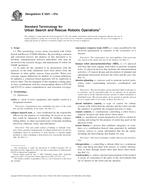Potřebujeme váš souhlas k využití jednotlivých dat, aby se vám mimo jiné mohly ukazovat informace týkající se vašich zájmů. Souhlas udělíte kliknutím na tlačítko „OK“.
ASTM E2566-08
Standard Test Method for Determining Visual Acuity and Field of View of On-Board Video Systems for Teleoperation of Robots for Urban Search and Rescue Applications
Automaticky přeložený název:
Standardní zkušební metoda pro stanovení zrakové ostrosti a zorného pole na palubě Video Systems pro Teleoperation robotů pro Urban Search and Rescue aplikace
NORMA vydána dne 1.2.2008
Informace o normě:
Označení normy: ASTM E2566-08
Poznámka: NEPLATNÁ
Datum vydání normy: 1.2.2008
Kód zboží: NS-45617
Počet stran: 6
Přibližná hmotnost: 18 g (0.04 liber)
Země: Americká technická norma
Kategorie: Technické normy ASTM
Kategorie - podobné normy:
Anotace textu normy ASTM E2566-08 :
Keywords:
field of view, remote operation, robots, teleoperation, urban search and rescue, video systems, visual acuity, ICS Number Code 13.200 (Accident and disaster control)
Doplňující informace
| Significance and Use |
|
Responder-defined requirements for these test methods are documented in a preliminary document entitled “Statement of Requirements for Urban Search and Rescue Robot Performance Standards.” Field of View is important in terms of the ability of the operator to drive the robot. Looking at the world through a zoom lens is like “looking through a soda straw.” Looking with a 30 or 40° field of view lens is like “driving with blinders on.” On the other hand, using a very wide field of view lens (with a field of view of 120 or 150°), the operator’s use of optic flow to cue depth perception is severely degraded and navigating in a tight environment is very difficult. Multiple cameras are recommended, with one providing a very wide field of view or all together providing a very wide field of view. Far Vision Visual Acuity is important for both unmanned air vehicles (UAVs) and ground vehicles for wide area survey. Zoom is required for ground vehicles for wide area survey. Near Vision Visual Acuity is important for ground vehicles for wide area survey in examining objects at close range and also for small robots which operate in constrained spaces. Testing in the dark is important for small robots since they must sometimes operate in spaces with no ambient lighting. |
| 1. Scope |
|
1.1 This test method covers the measurement of several key parameters of video systems for remote operations. It is initially intended for applications of robots for Urban Search and Rescue but is sufficiently general to be used for marine or other remote platforms. Those parameters are (1) field of view of the camera system, (2) visual acuity at far distances with both ambient lighting and lighting on-board the robot, (3) visual acuity at near distances, again in both light and dark environments, and (4), if available, visual acuity in both light and dark environments with zoom lens capability. 1.2 These tests measure only end-to-end capability, that is, they determine the resolution of the images on the display screen at the operator control unit since that is the important issue for the user. 1.3 This test method is intended to be used for writing procurement specifications and for acceptance testing for robots for urban search and rescue applications. 1.4 This test method will use the Snellen fraction to report visual acuity; readers may wish to convert to decimal notation to improve intuitive understanding if they are more familiar with that notation. Distances will be given in metres with English units in parentheses following. 1.5 This standard does not purport to address all of the safety concerns, if any, associated with its use. It is the responsibility of the user of this standard to establish appropriate safety and health practices and determine the applicability of regulatory limitations prior to use. |
Podobné normy:
Historická
1.6.2009
Historická
1.8.2007
Historická
1.7.2010
Historická
1.6.2014
Historická
1.6.2014
Historická
1.10.2007
Doporučujeme:
Aktualizace technických norem
Chcete mít jistotu, že používáte pouze platné technické normy?
Nabízíme Vám řešení, které Vám zajistí měsíční přehled o aktuálnosti norem, které používáte.
Chcete vědět více informací? Podívejte se na tuto stránku.



 ASTM E2413-04(2009)..
ASTM E2413-04(2009).. ASTM E2521-07a
ASTM E2521-07a ASTM E2541-10
ASTM E2541-10 ASTM E2542-08(2014)..
ASTM E2542-08(2014).. ASTM E2543-08(2014)..
ASTM E2543-08(2014).. ASTM E2592-07
ASTM E2592-07
 Cookies
Cookies
